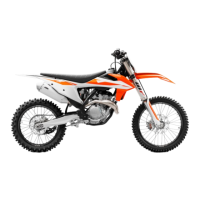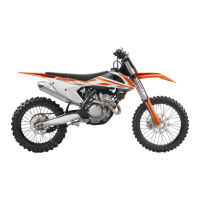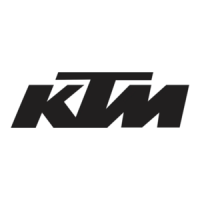
 Loading...
Loading...
Do you have a question about the KTM 350 SX-F and is the answer not in the manual?
| Displacement | 349.7 cc |
|---|---|
| Bore x Stroke | 88 mm x 57.5 mm |
| Starter | Electric starter |
| Transmission | 5-speed |
| Cooling | Liquid cooled |
| Frame | Central Double-Cradle Type 25CrMo4 Steel |
| Front Suspension | WP XACT-USD, Ø 48 mm |
| Rear Suspension | WP XACT Monoshock with linkage |
| Front Brake | Disc brake |
| Rear Brake | Disc brake |
| Ground Clearance | 370 mm |
| Seat Height | 950 mm |
| Ignition | Keihin EMS |
| Final Drive | Chain |
| Engine Type | Single-cylinder, 4-stroke |
| Fuel Tank Capacity | 7.2 L |
Owner's manual for KTM 350 SX-F and 350 XC-F models.
Identifies the specific article number of the manual.
Defines the intended use of the SX-F and XC-F models.
Explains the meaning of danger, warning, caution, and note symbols.
Covers dangers of accidents and poisoning related to safe operation.
Describes the clutch lever and its operation.
Describes the electric starter button and its operation.
Explains the functions of the combination switch for engine mapping and controls.
Covers essential safety advice and checks before initial use.
Offers advice on preparing the vehicle for challenging conditions.
Lists essential checks before every trip to ensure safe operation.
Covers safe and effective braking techniques.
Explains how to adjust chassis settings based on rider weight.
Explains how to check the static sag of the shock absorber.
Explains how to bleed the fork legs to remove air.
Details the steps for removing the shock absorber.
Guides on checking the front brake fluid level.
Guides on changing the front brake linings, with warnings about incorrect maintenance.
Explains the process of removing the front wheel, including brake caliper and spindle.
Details how to check and correct tire air pressure.
Guides on safely removing the motorcycle battery.
Guides on checking antifreeze and coolant levels, with warnings.
Details how to change the throttle response by adjusting the guide plate.
Details the process of changing engine oil, filter, and cleaning the oil screen.
Provides instructions and warnings for cleaning the motorcycle, including pressure washer use.
Provides steps for storing the motorcycle for longer periods, including fuel, battery, and protection.
Lists possible causes and actions when the engine cranks but doesn't start.
Lists malfunction indicator lamp codes and their error conditions.
Provides detailed technical specifications for the engine.
Lists tightening torques for various chassis components.
Specifies standard classifications and recommended suppliers for engine oil.
Recommends a motorcycle cleaner.
Explains the JASO T903 MA2 standard for motorcycle engine oils.
Explains that yellow/orange symbols indicate errors or active driving aids.











